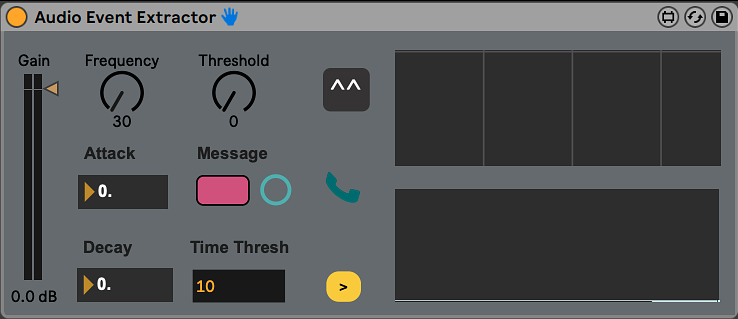Device Details
Overview
| Name | Version: | Audio Event Extractor 1.0 |
| Author: | wisdomwater |
| Device Type: | Audio Effect |
| Description: | AUDIO EVENT EXTRACTOR: - This is an audio m4l device that is used to extract audio event information and send triggers using Smartphones environment integration. In order to make this device work you will need RING.amxd device by Smartphones, which will let you convert a trigger message to a midi note, which can be used to trigger a drum rack for example. - Frequency control defines what frequency the device is listening to, i.e. the frequency of a very narrow band pass filter. - Threshold control defines at what level the post filter audio will be classified as detected and hence, a trigger will be fired. - Attack & Decay control the respective stages of the envelope follower post filter. Small values mean the extraction will be more sensitive to audio events, while larger values will make the detection less sensitive. - Time Threshold defines how many milliseconds it will take for the next trigger to fire. Think of it as a hysteresis control for the detector. If the detection is super sensitive you might have 10 triggers fire within 10 ms, which in most cases isn't very musical, this way Time Thresh allows us to extract "cleaner" patterns from audio sources. The minimum time between triggers is 10ms and maximum is 100ms. This range has proven to be the most useful in musical applications. - Gain control sets the input gain for the device, it is recommended to keep it around 0db (where the grey line is at the top of the slider). The maximum value of a slider will add +10 DB gain, this is so you can still mix your audio source, but have flexibility to keep it at the optimal level for the event detector. NOTE: Gain slider only affects the audio that goes to the event detector, the actual audio fed to the device itself is bypassed, which allows the device to sit in your audio path without changing the original audio source in any way. - Message send box is used to enter a piece of text, when the event triggers this box a message with unique text is sent to smartphones environment. If the text inside a receiver box (RING device for example) matches the text inside the send box, the two devices start communicating (i.e. RING will fire a midi note once the Audio Event Extractor detects an event). Message boxes are used as a way to connect devices anywhere in your smartphones environment, just like cables on a modular synth. - Phone button is used to reset all smartphone intergated devices (double mouse click). This is useful when you have a sequencer running off AEE and you want it to return to step 1. - The arrow in the bottom right corner opens up two screens, the top one shows the post filter audio and the bottom one shows how the envelope follower reacts to the input signal. (These two will most likely be changed / tweaked) in the future, but are a nice way to understand what is going on inside the device. WORKFLOW: - Load the device to an audio track / send&return track / midi track with external instrument. - Adjust the gain slider to the audio is around 0dB. - Tweak the Frequency and Threshold until you see the blue ring next to the message box flash, this means the event is being extracted. - Write some kind of text inside the Message box, for example 'hey'. - Load smartphones ring.amxd device on a midi track with a drum rack, write 'hey' inside the grey receiver box and you should now be able to select what midi note you want ring.amxd to send everytime it receives a trigger from AEE. Match that midi note to a slot inside the drum rack and you should hear the extracted pattern trigger your sample. NOTE ON LATENCY: - As with any realtime processor, there is some latency involved. In order to sync the incomming audio and what is being played by the AEE you either need to have around 10-20 ms negative track delay on the track that uses AEE or 10-20 ms of positive track delay on the track that is being triggered by AEE. Personally I found that having AEE on a send & return track makes the workflow much more intuitive as you can send any audio track to the Return track and you only have to add one negative track delay on the return track so solve slight processing delay. |
Details
| Live Version Used: | 11.1.18 |
| Max Version Used: | 8.1.5 |
| Date Added: | Aug 09 2022 18:06:57 |
| Date Last Updated: | No Updates |
| Downloads: | 288 |
| ⓘ License: | None |
Average Rating
Log in to rate this device |
-n/a- |
Files
| Device File: | Audio Event Extractor.amxd |
Login to comment on this device.
Browse the full library